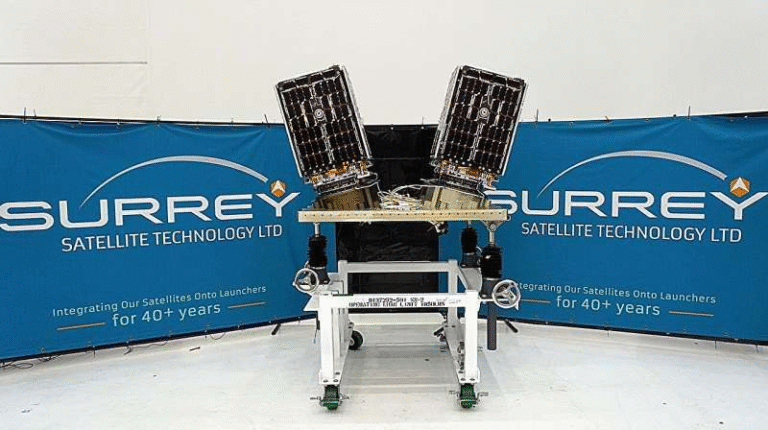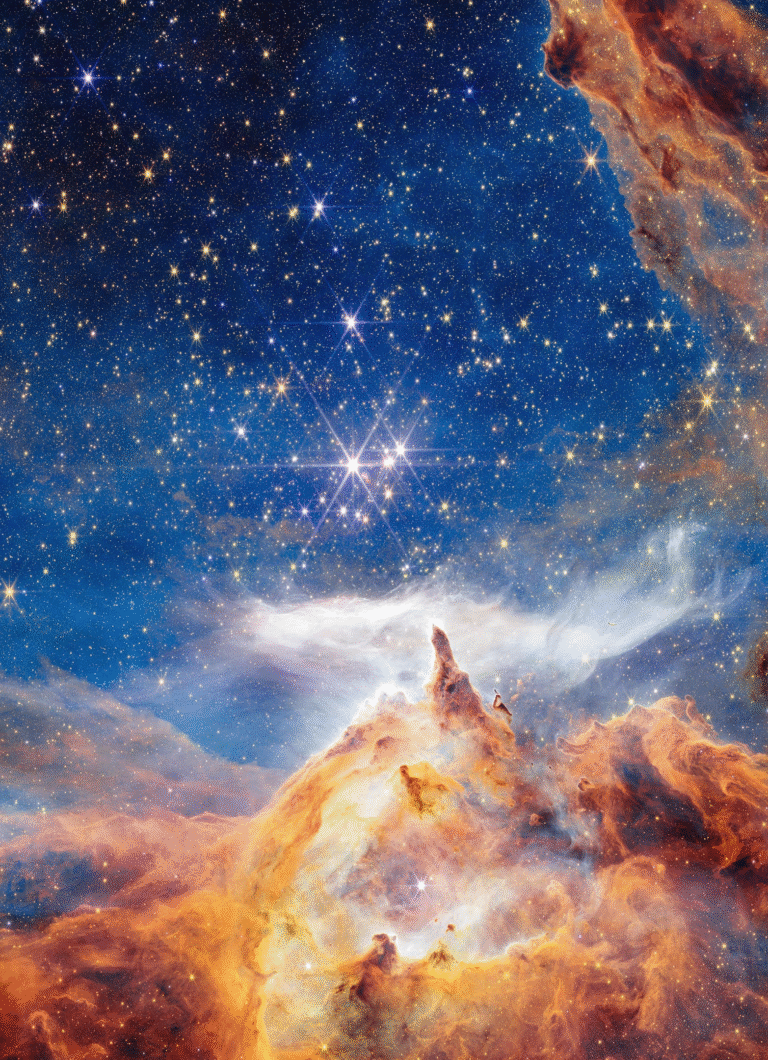A Brown Dwarf with Stormy Weather Found Orbiting a Red Dwarf 55 Light-Years Away

Astronomers have discovered a fascinating brown dwarf—a celestial object that’s neither a true star nor a planet—orbiting a small red dwarf star just 55 light-years from Earth. This newly identified companion, named J1446B, circles its host star LSPM J1446+4633 (or simply J1446) and displays remarkable signs of atmospheric activity, including what appear to be storms and cloud formations.
This discovery was made possible through a clever combination of three powerful observational techniques—radial velocity measurements, direct imaging, and astrometric data—bringing together the capabilities of ground-based and space-based observatories. The study, led by researchers from the Astrobiology Center (Japan), California State University, Northridge, and Johns Hopkins University, provides one of the clearest pictures yet of how brown dwarfs form and behave, especially those orbiting small stars like red dwarfs.
The System: J1446 and Its Companion
The host star J1446 is a mid-type M dwarf, a cool and faint red dwarf star. These stars are the most common type in our galaxy—over half of all stars are M dwarfs—but because they are so dim, studying them and their companions can be a serious challenge.
Orbiting this little red star is J1446B, a brown dwarf weighing in at roughly 60 times the mass of Jupiter (59.8 ± 1.5 MJup, to be exact). That’s too massive to be considered a planet, but still not enough for sustained hydrogen fusion like in normal stars. The pair is located at a distance of about 55 light-years (17 parsecs) from Earth, making it relatively nearby in cosmic terms.
The brown dwarf’s orbit is another interesting detail—it circles its host at about 4.3 astronomical units (au), or roughly four times the distance between Earth and the Sun, completing a full orbit in about 20 years.
The Triple-Technique Discovery
What makes this discovery stand out is how it was made. Instead of relying on just one type of observation, the researchers combined three complementary techniques to accurately measure the companion’s mass, orbit, and atmospheric behavior.
- Radial Velocity (RV) Measurements – Using the InfraRed Doppler (IRD) instrument on Japan’s Subaru Telescope, scientists spent six years measuring tiny shifts in the star’s spectrum caused by the gravitational tug of its unseen companion. These shifts reveal how the star “wobbles” due to J1446B’s pull.
- Direct Imaging – The team then used the W. M. Keck Observatory in Hawaii, equipped with adaptive optics and infrared imaging, to directly capture light from the brown dwarf. In the processed infrared image, the host star is masked out, while the faint brown dwarf appears clearly beside it.
- Astrometric Data – Finally, using data from the Gaia spacecraft, researchers measured the minute acceleration in the host star’s motion across the sky. Gaia’s precise positional data provided the missing piece, helping determine the brown dwarf’s orbit and true mass.
By merging all three datasets—radial velocity, direct imaging, and Gaia’s astrometry—the team broke the long-standing degeneracy problem that usually plagues such discoveries. Normally, radial velocity alone can’t tell us the exact mass of a companion because it depends on the tilt of its orbit. Adding Gaia and Keck data solved that, allowing the scientists to pin down J1446B’s true mass and orbit with impressive accuracy.
A Stormy Brown Dwarf
Perhaps the most intriguing finding is that J1446B isn’t a static, featureless object—it shows significant brightness variations, roughly 30% changes in infrared light over time. That’s a huge signal, suggesting that clouds and storms are forming, dissipating, and circulating through its atmosphere.
These variations were picked up during near-infrared observations, indicating that the brown dwarf’s atmosphere could be dynamic and weather-driven, with patchy clouds and possibly fast-moving jet streams. In many ways, it behaves more like a gas giant planet than a star.
For scientists, observing “weather” on such objects helps refine atmospheric models not just for brown dwarfs, but also for gas giant exoplanets—especially those with similar temperatures and chemical compositions.
Why Brown Dwarfs Are So Interesting
Brown dwarfs are often described as “failed stars.” They form in much the same way as stars—through the gravitational collapse of gas clouds—but they don’t gather enough mass to ignite continuous hydrogen fusion in their cores. This makes them a sort of bridge between stars and planets.
Their masses typically range between 13 and 75 Jupiter masses. Below that, you get planets; above that, you get stars. But in between lies this mysterious class of objects that glow dimly, primarily from residual heat and deuterium fusion, not from sustained stellar burning.
What makes J1446B especially valuable is that it provides a benchmark system. Because its mass and orbit are now precisely measured, it can help astronomers test models of brown dwarf formation—whether they form like stars through direct collapse or like planets within disks.
Additionally, studying its atmosphere gives insight into cloud physics, temperature gradients, and circulation patterns in substellar atmospheres—key pieces of knowledge that also apply to giant exoplanets.
Why M Dwarfs Matter
M dwarfs are small, cool, and faint—but they dominate our galaxy. They make up more than half of all stars in the Milky Way. Many of the most exciting exoplanet discoveries in recent years have been around M dwarfs, such as the TRAPPIST-1 system, because their low brightness makes it easier to detect small planets via transits and radial velocity.
However, M dwarfs are also challenging targets. They’re faint in visible light, requiring specialized infrared instruments like Subaru’s IRD to study their companions effectively. Because of that, the frequency of brown dwarfs and planets around M dwarfs is still uncertain. Discoveries like J1446B help fill in that gap and refine our understanding of how common such systems are.
Significance of the Discovery
This discovery is more than just a new entry in the catalog of brown dwarfs. It showcases the power of collaboration between ground and space observatories. Gaia’s precise astrometry, Subaru’s radial velocity data, and Keck’s direct imaging combined perfectly to give a complete view of the system.
The study also marks the first successful use of Gaia-only data—without relying on older missions like Hipparcos—to characterize a brown dwarf orbiting a faint red dwarf. That’s an important milestone, proving that future Gaia releases could uncover many more such systems.
The precision achieved here is remarkable. With all datasets combined, the researchers determined a mass of about 59.8 Jupiter masses, a separation of 4.3 au, and an orbital period of ~20 years. Those numbers are accurate enough to use this system as a testbed for theories of stellar and substellar evolution.
Looking ahead, the team plans to conduct follow-up spectroscopic and photometric monitoring to map the brown dwarf’s atmosphere and weather patterns in more detail. The hope is to understand how clouds evolve, what kind of winds blow across its surface, and whether its variability is linked to rotation or deeper atmospheric layers.
Broader Impact and Future Outlook
The discovery of J1446B underlines a broader trend in astronomy: we’re entering an era where multi-technique observations are essential. No single method can reveal the full picture, but when combined, they can unlock detailed insights into the mass, composition, and dynamics of faint companions.
Brown dwarfs like J1446B also play a vital role in bridging the gap between exoplanet science and stellar astrophysics. By studying them, we improve our models of how both planets and stars form, evolve, and interact.
As new data from Gaia, the James Webb Space Telescope (JWST), and future observatories like the Nancy Grace Roman Telescope become available, more discoveries like this one are expected. Each new system adds another piece to the puzzle of how our galaxy builds its diverse array of worlds.
Research Reference
Paper Title: Direct Imaging Explorations for Companions from the Subaru/IRD Strategic Program II: Discovery of a Brown-dwarf Companion around a Nearby Mid-M-dwarf LSPM J1446+4633
Authors: Taichi Uyama et al.
Journal: The Astronomical Journal (2025)
DOI: 10.3847/1538-3881/ae08b6




